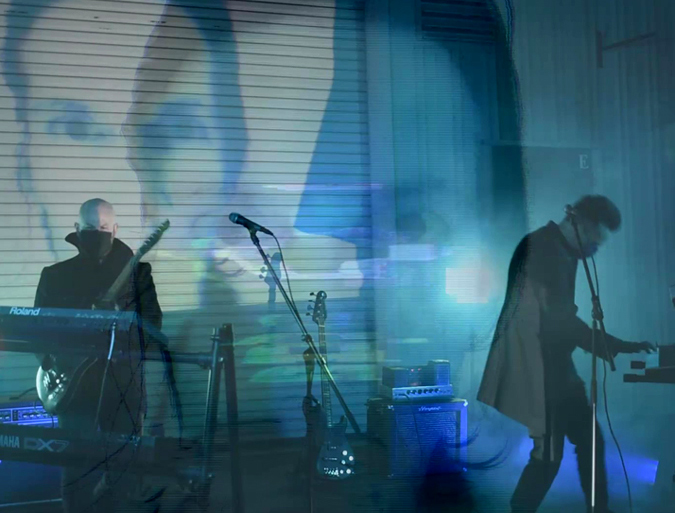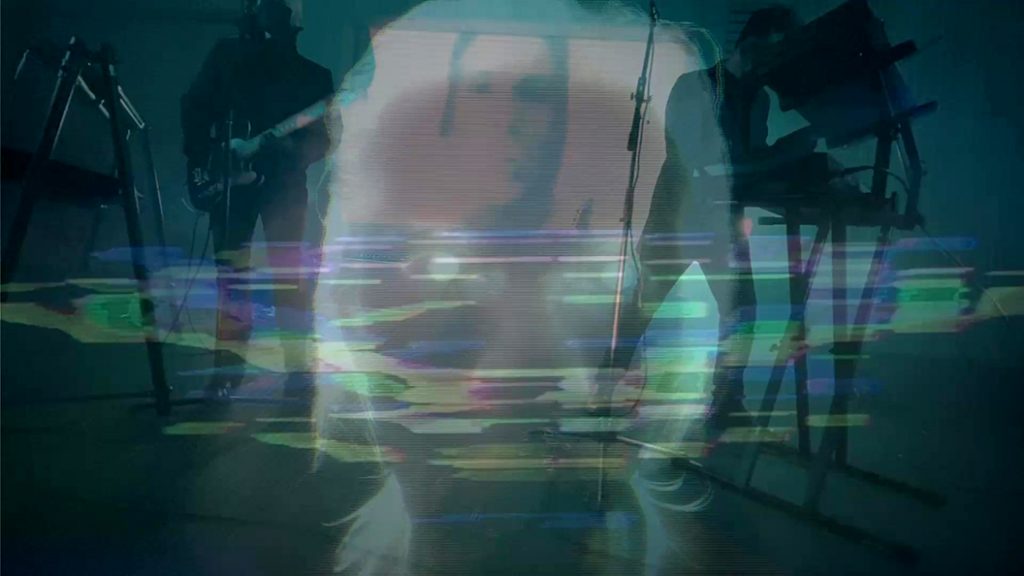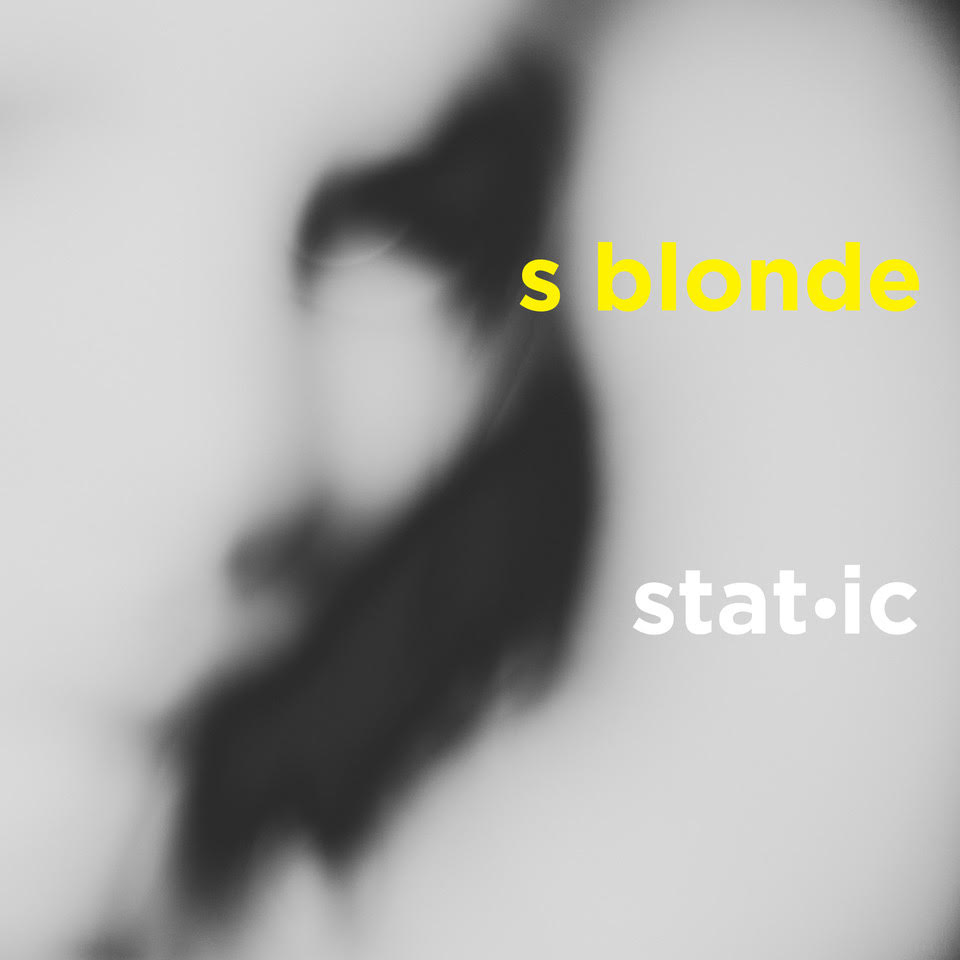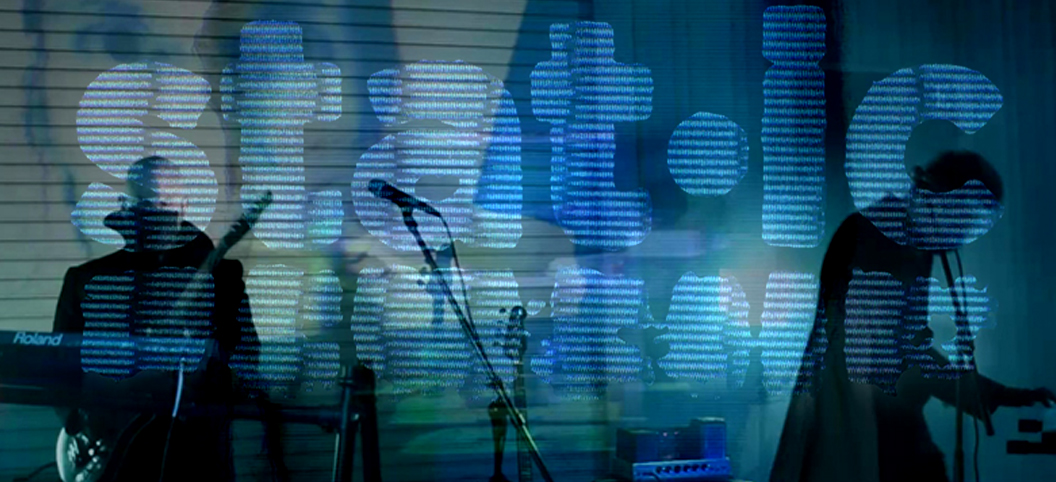By Keith Walsh
The stunning debut video by Static of their tune “S Blonde” has arrived. Despite my inquiries, the members are secretive about the title of this fascinating track. I spoke with all of of them at length, however, about the style, the process, and the future of Static.
Static is equal parts art collective and synth rock band. With frontman Julian Shah-Tayler writing lyrics, instrumentalists Darwin Meiners and Dustin Heald providing synths, guitars and background vocals, and visual artist Mark Gleason having equal input on the shape of the band’s sound, the concept of Static calls upon its members to get out of their comfort zones by working remotely and by challenging each other in various ways.
“We really are just creating these fragments — thirty second, forty second fragments usually,” Darwin said. “Me and Dustin pass them back and forth, and then when we get five or six we send them to Julian and see which ones he reacts to, just like listening to them once, and then we expand on that, and then we send them to everyone and everyone chimes in.”
Working Within Limitations
Of the collaboration leading to the assemblage of completed tracks, Darwin told me: “We would send stuff back and forth, and sometimes I would say (to Dustin Heald) ‘I know you can do better than that.’ We’re just trying to be honest, We’re not trying to be driven by anything other than what we all think sounds really cool. Unless somebody gets something that they’re really just in love with. If you really, really love a part, then we invite you to fight for it. But if you don’t really love it, then let’s try something else. That’s kind of one of our mottos.” After Darwin and Heald worked out their fragments, Gleason and Shah-Tayler would provide their feedback.
As all four members told me, Static was designed as a project with limitations, using only sounds and textures that were available in the 1980s. This doesn’t mean specifically only vintage gear, but rather sounds of the 80s. For example, Darwin said that for the drum sound of “S Blonde,” which is a prominent, stark feature of the track, they used samples of a Linn Drum machine sequenced in Logic and Cubase, rather than an actual Linn Drum machine.
Darwin explains further: “It’s not that we have to use things from the 80s …It’s more like sounds that were available at that time. So we can’t use a bunch of stuff that wasn’t available at that time. So you’re not going to hear modern synthesizers, but it may be a modern trigger and also I work with Roland and so I I have the Roland Plug In Suite (The Roland Cloud).”
Of the Roland Cloud, Darwin said: They’re vintage, especially the Juno and the SH-101 and stuff like that. They sound really, really good. But I always re-amp everything . They have a lot of authentic 80s modeling on there.” Darwin told me he also uses Arturia virtual synths, a tactic that avoids the maintenance issues of keeping expensive, space consuming vintage gear.
Darwin’s approach to re-amping synthesizers is a subject worthy of a future article. Suffice it to say for now, that by running synths, both virtual and hardware, through an array of analog outboard effects and amplifiers, he gets a sound that’s vibrant and immediate.

When asked if Static might ever create a dark love song or a happy 80s style song, Darwin said: “There’s no thought that goes into that type of thing. There’s no thought that goes ‘we’ve got some slow ones, we need some fast ones. There’s no way that we could say ‘let’s write a slow song,’ it would just have to happen by accident, or just by the way. And the same thing about happy or sad. I think that a few of the songs will be a little bit less edgy, or in your face literally…but there is a certain sort of used future about this project. It’s a little rough. It’s a little bit dinged up. There’s nothing very pretty in there. I mean, I think Joy Division’s beautiful, but it’s very, you know, it’s very cold at times and rigid.”
‘Embracing The Shadow Side’
There’s an on-edge quality to Julian Shah-Tayler’s lyrics and vocal performance in “S Blonde.” It turns out this is a product of his approach to the project, as well as to the time of its creation, which he tells me was during the riots over George Floyd murder.
The vocal performance was done in a single take. As Shah-Tayler told me: “I find these darker sounds are quite interesting, because in Jungian psychology, he always advocates embracing the shadow side. And one of the other tropes related to it is that everybody has one. So I’m looking into the idea that I’m sort of projecting staring down the barrel of somebody’s gun, and having no connection with them, like ‘nature, red in tooth and claw…’ and then realizing to them, there’s the exact same thing. The mirror is a revealer of your own closed-ness and emptiness and anger and all that stuff. What you realize in somebody else is what you’re fearing in yourself.”
If art holds a mirror to society , what “S Blonde” reveals is not flattering at all. ‘“There’s a lot of projection in the divisive nature of the Trump presidency.,” Shah-Tayler said “Certainly, we, we would call ourselves ‘liberals,’ and I mean we have battled often, especially on social media –which is the big black vacuum of Hell — and especially on social media you would start battling with people who are on your inverted comma’s ‘side’ because they’ve taken it upon themselves to exacerbate things by pushing it out way too far. And nobody is seeing eye to eye, and everybody is battling the ‘complete realistic spectrum.’ And that’s kind of what this song is about, expressing such depth.”
I asked Shah-Tayler to explain further. “The realistic spectrum of humanity, where we all kind of want the same thing, which is safety and love and joy and pleasure for us and our friends. That’s the reality of humanity in my book.”
‘Big Brother Imagery’
The video for ‘S Blonde,” which was directed and edited by Dustin Heald emphasizes the same darkness that Shah-Tayler was expressing . I asked Heald what it was about the song that inspired his visual take. “The way the song panned out,” he said, “it has sort of a robotic, mechanical vibe to it,” he says. “And that sort of inspired the cold lighting — and the negative imagery came as a result of the footage that Julian sent me.”
Heald continues: “The video was done in sort of a pandemic way also. Julian’s a little farther away than Darwin and I are, and we knew we weren’t going to get the three of us in a room together, and at the time, getting three people in a room together is the last thing you want to do, during a pandemic, so the idea for the video was to get some footage of Julian doing his thing, and project it on a wall, and use it like a Big Brother kind of imagery.”
“So we had him shoot his first,” Heald continues, “and the style and the specific image of what he came up with, the white face on the white background, very stark, that inspired the playing with the negative images, just because it looked cool. When I started playing with the footage it evoked something very sort of almost demonic. It’s just one of those things — not everything in art is planned out, it just sort of happens. You stumble across them and it works perfectly.” Heald edited the video in DaVinci Resolve. “It’s a free editing software but it’s got quite a bit of color correction and good tools,” he said.

I asked him how he imagines Static evolving from their mid-80s sound in the studio to a live project. “I would love to see, and it was always intended to be something that we could perform live, and in fact in our initial idea of keeping it someone sparse and not overdoing the production layers of instruments lends itself to live production. At any given time we didn’t want to have more happening that a given trio of people could perform live. So even though there’s a programmed aspect of it, the drum machine and some of the synth programming, we always sort of wanted and hoped to perform it live.”
Heald continues: “Nobody expects a year of pandemic to keep things from happening. So we’ll see if we get a chance to do that. That would be part of the evolution of it. I would love to see it over time change from something that’s being cooked up in a couple of individuals’ studios and shared back and forth into something where the four of us are in a room together kind of cooking stuff up.”
‘A Rorschach Test’
Visual artist Mark Gleason gave me some insight into the collaborative meetings between the four members of Static that resulted in the assembling of the finished product. “We do Zoom and we banter around a whole lot,” he said, “and then finally get down to it and it’s mostly technical talk between those guys. But, you know, (I’ll say) I think the drums need to be up more upfront or let’s just stay on the guitar for another chord.”
When discussing the visual style of Static, Gleason and his three colleagues decided on something retro, with references to Peter Saville’s work for Factory Records, as well as the approach of Andy Warhol’s studios in New York of the late 70s and early 80s. Gleason told me that he wants the cover art for Static singles to be a kind of “Rorschach” test for the viewer.
“In terms of the visual part,” he said, (I want) to leave a little bit up to the viewer, leave a little bit up to the listener to sort of fill in the gaps and participate. It’s just kind of having a mystique, kind of generating a little bit of input from the listener…It’s more of that warpy, black and white, ‘what the hell am I looking at?’ kind of thing. So that’s the look for these initial four (songs).” Indeed, none of the members of Static would reveal to me the meaning of the cryptic song title.

Gleason continued, “I like artwork to sort of stop you in your tracks for a second and go. ‘huh? I’m generating a giant question mark about this or I’m generating this is making me think of a story or explain – what the hell is going on?’ So, with the music, Darwin mentioned the concept, he was thinking a lot of, you know, the film THX 1138, (George Lucas’s. first project). Yeah, he was really thinking of that kind of very rigid, almost totalitarianism-looking future thing. I was trying to throw a little bit of Clockwork, Orange into it, and at one point we actually thought about naming the band ‘Droog.’ A little bit of that went into it. It almost went a little Daft Punk, in terms of the anonymity of it, and actually you see that a little bit in Dustin’s and Darwin’s roles in the video.”
http://www.darwinmeiners.com/
http://www.dustinheald.com/
https://www.markgleason.org/
https://www.julianshahtayler.com/
Static On YouTube
finis
